
Mars, the fourth planet from the Sun, has appeared as a setting in works of fiction since at least the mid-1600s. Trends in the planet's portrayal have largely been influenced by advances in planetary science. It became the most popular celestial object in fiction in the late 1800s, when it became clear that there was no life on the Moon. The predominant genre depicting Mars at the time was utopian fiction. Around the same time, the mistaken belief that there are canals on Mars emerged and made its way into fiction, popularized by Percival Lowell's speculations of an ancient civilization having constructed them. The War of the Worlds, H. G. Wells's novel about an alien invasion of Earth by sinister Martians, was published in 1897 and went on to have a major influence on the science fiction genre.
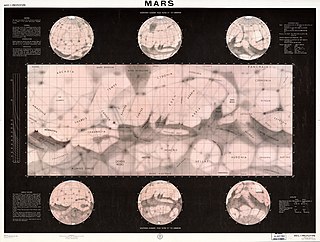
During the late 19th and early 20th centuries, it was erroneously believed that there were "canals" on the planet Mars. These were a network of long straight lines in the equatorial regions from 60° north to 60° south latitude on Mars, observed by astronomers using early telescopes without photography.
Stephen Goosson was an American film set designer and art director.
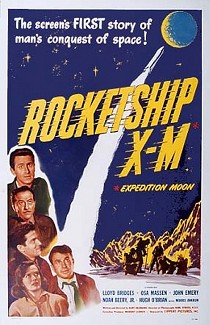
Rocketship X-M is a 1950 American black-and-white science fiction film from Lippert Pictures, the first outer space adventure of the post-World War II era. The film was produced and directed by Kurt Neumann and stars Lloyd Bridges, Osa Massen, John Emery, Noah Beery Jr., Hugh O'Brian, and Morris Ankrum.

Flash Gordon's Trip to Mars is a 1938 Universal Pictures 15–chapter science-fiction movie serial based on the syndicated newspaper comic strip Flash Gordon. It is the second of the three Flash Gordon serials made by Universal between 1936 and 1940. The main cast from the first serial reprise their roles: Buster Crabbe as Flash Gordon, Jean Rogers as Dale Arden, Frank Shannon as Dr. Alexis Zarkov, Charles B. Middleton as Ming the Merciless, and Richard Alexander as Prince Barin. Also in the principal cast are Beatrice Roberts as Queen Azura, Donald Kerr as Happy Hapgood, Montague Shaw as the Clay King, and Wheeler Oakman as Ming's chief henchman. The serial was followed by Flash Gordon Conquers the Universe (1940).

Mission to Mars is a 2000 American science fiction adventure film directed by Brian De Palma, written by Jim Thomas, John Thomas, and Graham Yost, and suggested by Disney's theme park attraction of the same name. The film depicts the first crewed Mars exploration mission going awry; American astronaut Jim McConnell helps to coordinate a rescue mission for a colleague. Principal support actors were Tim Robbins, Don Cheadle, Connie Nielsen, Jerry O'Connell, and Kim Delaney.

Robinson Crusoe on Mars is a 1964 American science fiction film directed by Byron Haskin and produced by Aubrey Schenck that stars Paul Mantee, Victor Lundin, and Adam West. It is a science fiction retelling of the classic 1719 novel Robinson Crusoe by Daniel Defoe. The film was distributed by Paramount Pictures and filmed in Technicolor and Techniscope.

Zombies of the Stratosphere is a 1952 black and white Republic Studios serial directed by Fred C. Brannon, with a screenplay by Ronald Davidson, and special effects by Republic's Lydecker brothers. It was intended to be Republic's second serial featuring "new hero" Commando Cody and the third 12-chapter serial featuring the rocket-powered flying jacket and helmet introduced in King of the Rocket Men (1949). Instead, for reasons unknown, the hero was renamed "Larry Martin", who must prevent Martian invaders from using a hydrogen bomb to blow Earth out of its orbit, so that the Martians can move a dying Mars into a much closer orbital position to the Sun. As in Radar Men from the Moon, much of the screen time for each of the dozen chapters is spent on fistfights and car chases between the heroes and a gang of earthly crooks hired by renegade scientist Dr. Harding and his extraterrestrial colleague Marex to steal and stockpile the Atomic supplies needed for construction of the H-bomb.

Mars Attacks! is a 1996 American black comedy science fiction film directed by Tim Burton, who also co-produced it with Larry J. Franco. The screenplay by Jonathan Gems was based on the Topps trading card series of the same name. The film features an ensemble cast consisting of Jack Nicholson, Glenn Close, Annette Bening, Pierce Brosnan, Danny DeVito, Martin Short, Sarah Jessica Parker, Michael J. Fox, Pam Grier, Rod Steiger, Tom Jones, Lukas Haas, Natalie Portman, Jim Brown, Lisa Marie, and Sylvia Sidney in her final film role.

Elmer Goodfellow "El" Brendel was an American vaudeville comedian turned movie star, best remembered for his dialect routine as a Swedish immigrant. His biggest role was as "Single-0" in the sci-fi musical Just Imagine (1930), produced by Fox Film Corporation. His screen name was pronounced "El Bren-DEL".

Flying Disc Man from Mars is a 1950 Republic Pictures 12-chapter black-and-white science fiction adventure film serial, produced by Franklin Adreon, directed by Fred C. Brannon, that stars Walter Reed, Lois Collier, Gregory Gaye, James Craven, Harry Lauter, and Richard Irving. Disc Man is considered a weak example of the serial medium, even compared to other post-World War II serials. In 1958 Republic edited the serial's 167 minutes of footage into a 75-minute feature, released under the new title Missile Monsters.
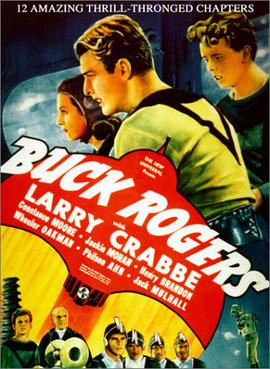
Buck Rogers is a 1939 science fiction film serial, produced by Universal Pictures. It stars Buster Crabbe as the eponymous hero, Constance Moore, Jackie Moran and Anthony Warde. It is based on the Buck Rogers character created by Philip Francis Nowlan, who had appeared in magazines and comic strips since 1928.

Flight to Mars is a 1951 American Cinecolor science fiction film drama, produced by Walter Mirisch for Monogram Pictures, directed by Lesley Selander, that stars Marguerite Chapman, Cameron Mitchell, and Arthur Franz.

Invaders from Mars is a 1986 American science fiction horror film, directed by Tobe Hooper from a screenplay by Dan O'Bannon and Don Jakoby. It is a remake of the 1953 film of the same name, and is a reworking of that film's screenplay by Richard Blake from an original story by John Tucker Battle. Its production was instigated by Wade Williams, millionaire exhibitor, science fiction film fan and sometime writer-producer-director, who had reissued the original film in 1978 after purchasing the copyright to the property. Elaborate creature and visual effects were supplied by Stan Winston and John Dykstra.

The War of the Worlds is a 1953 American science fiction film directed by Byron Haskin, produced by George Pal, and starring Gene Barry and Ann Robinson. It is the first of several feature film adaptations of H. G. Wells' 1898 novel of the same name. The setting is changed from Victorian era England to 1953 Southern California.

Mars Needs Moms is a 2011 American animated science fiction film co-written and directed by Simon Wells, produced by ImageMovers Digital and released by Walt Disney Pictures. Based on the Berkeley Breathed book of the same title, the film was animated through the process of performance capture and stars Seth Green, Dan Fogler, Elisabeth Harnois, Mindy Sterling, and Joan Cusack. It was the second and final film produced by ImageMovers Digital before the studio was shut down and re-absorbed into ImageMovers resulting in the company leaving the animation business for good. It tells the story of a nine-year-old boy named Milo who sets out to save his mother on Mars after she is abducted by Martians.
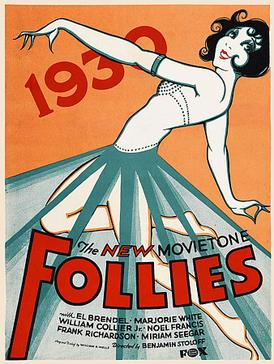
New Movietone Follies of 1930 is a 1930 American Pre-Code musical film released by Fox Film Corporation, directed by Benjamin Stoloff. The film stars El Brendel and Marjorie White who also costarred in Fox's Just Imagine in 1930.
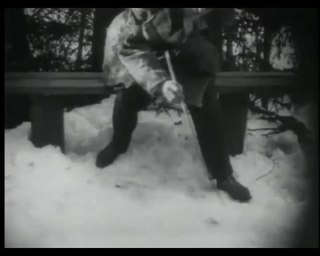
Aelita, also known as Aelita: Queen of Mars, is a 1924 Soviet silent science fiction film directed by Yakov Protazanov and produced at the Mezhrabpom-Rus film studio. It was based on Alexei Tolstoy's 1923 novel of the same name. Nikolai Tseretelli and Valentina Kuindzhi were cast in leading roles.

The War of the Worlds is a science fiction novel by English author H. G. Wells. It was written between 1895 and 1897, and serialised in Pearson's Magazine in the UK and Cosmopolitan magazine in the US in 1897. The full novel was first published in hardcover in 1898 by William Heinemann. The War of the Worlds is one of the earliest stories to detail a conflict between humankind and an extraterrestrial race. The novel is the first-person narrative of an unnamed protagonist in Surrey and his younger brother in London as southern England is invaded by Martians. It is one of the most commented-on works in the science fiction canon.

The Martian is a 2015 science fiction film directed by Ridley Scott and starring Matt Damon. Drew Goddard adapted the screenplay from the 2011 novel of the same name by Andy Weir. The film depicts an astronaut's lone struggle to survive on Mars after being left behind and the efforts of NASA to rescue him and bring him home to Earth. It also stars Jessica Chastain, Jeff Daniels, Kristen Wiig, Chiwetel Ejiofor, Sean Bean, Michael Peña, Kate Mara, Sebastian Stan, Aksel Hennie, Mackenzie Davis, Donald Glover, and Benedict Wong.



















